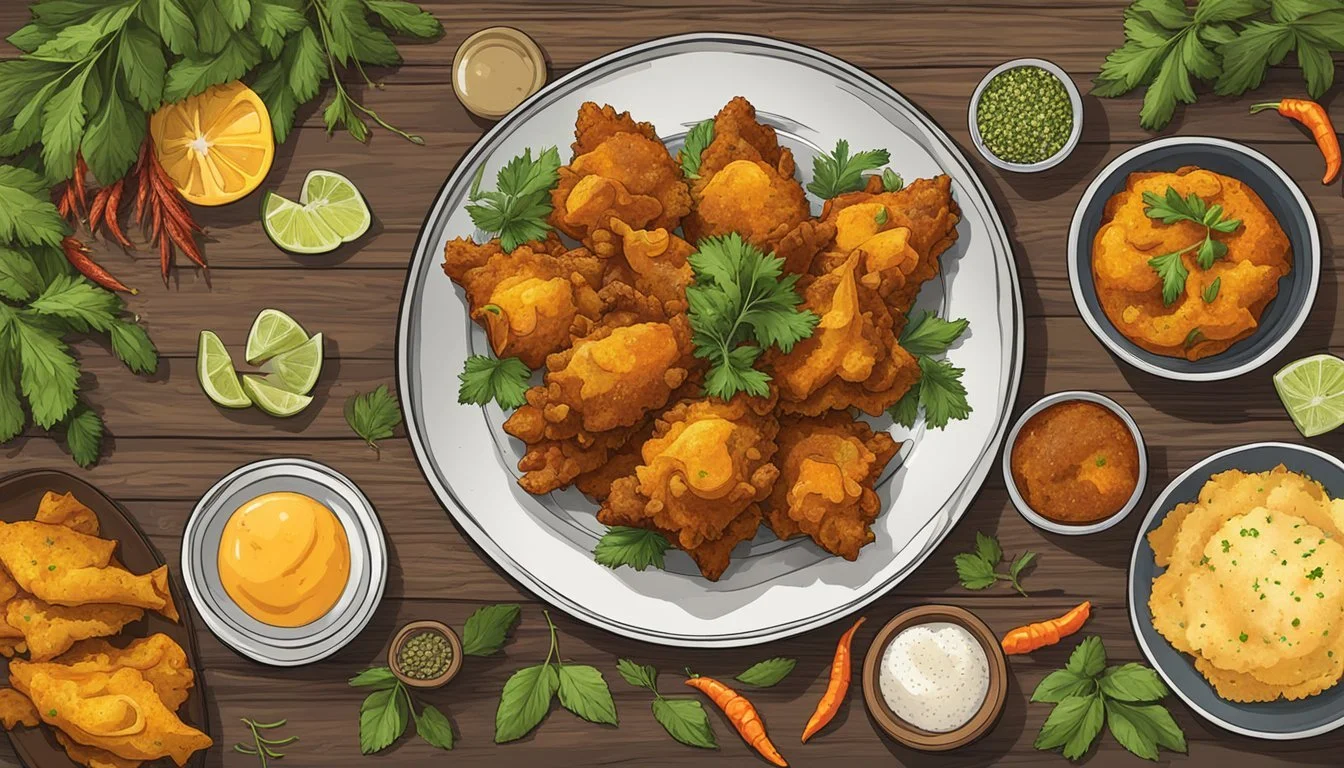How Long Do Fish Pakoras Last?
Best Storage Tips
Fish Pakoras are a beloved Indian appetizer, celebrated for their crispy texture and flavorful spice blend. Whether they're prepared for a family gathering or a festive celebration, these fritters often leave you wondering about their shelf life. Fish pakoras can last up to 2 days when stored properly in the refrigerator in an airtight container.
When considering how long fish pakoras last, it's important to note that their freshness and safety can be maximized with proper storage techniques. Once cooked, they should be allowed to cool completely before being transferred to a container. This not only ensures their crispiness but also helps in maintaining their original taste and quality.
If you have leftovers, reheating them properly is key to enjoying them later without compromising taste. Using an air fryer or oven ensures they regain some of their original crispiness, rather than becoming soggy. Always check for any unpleasant odors or texture changes before consuming stored fish pakoras.
Understanding Fish Pakoras
Fish pakoras are a popular snack made from marinated fish pieces coated in a spiced gram flour batter and deep-fried until crispy. Originating in the Indian subcontinent, this tasty dish combines fresh fish with aromatic spices, creating a flavorful and crunchy treat.
Origins and Popularity
Fish pakoras trace their roots to the Indian subcontinent, where they are a beloved part of street food culture. They are especially popular in regions where fish is abundant. Found at food stalls, festivals, and family gatherings, fish pakoras are enjoyed by people of all ages.
They are not limited to one specific region and have variations across different cultures. In many households, the recipe is adapted according to local tastes, reflecting the diverse culinary traditions of South Asia.
Key Ingredients
The key ingredients for making fish pakoras include fish, usually fillets cut into bite-sized pieces. The marination often involves ginger, garlic, and a blend of Indian spices. The spices may include cumin, chili powder, garam masala, and carom seeds (ajwain).
The batter is made from gram flour (besan) which gives it a crispy texture. Some recipes add rice flour or cornstarch for extra crunch. Water or egg is used to bind the batter, and the fish is deep-fried in hot oil until golden and crispy.
Preparing the Pakora Batter
To make fish pakoras, it is crucial to select the right type of fish and create a well-seasoned batter that coats the fish perfectly. This ensures the fish remains moist and flavorful after frying.
Selecting the Fish
Choosing the right fish is fundamental. Firm, white fish like cod, haddock, or tilapia are preferred for fish pakoras due to their mild flavor and texture. They hold their shape well during frying.
Before battering, ensure the fish is cut into bite-sized chunks. Freshness is key; fresher fish results in better texture and taste. A short marination with lemon juice, salt, and turmeric enhances flavor and helps eliminate any unwanted fishy smell.
Creating the Perfect Blend
The batter is a mixture of dry and wet ingredients ensuring a crispy finish. Gram flour (besan) is the primary component, often combined with corn flour or rice flour to enhance crispiness.
Spices are essential. Add garam masala, red chili powder, and turmeric to the batter for depth of flavor. Carom seeds or ajwain can be included for an aromatic touch. Adding a bit of water helps achieve the perfect consistency; the batter should be thick enough to coat the fish thoroughly but not too runny.
For additional flavor and texture, finely chopped mint, coriander leaves, or curry leaves can be incorporated into the batter.
Egg whites or a bit of oil can be added to improve adhesion and texture. Mix all ingredients well until the batter forms a smooth, lump-free paste. This careful blend ensures the fish is well-coated and results in a perfectly crispy and flavorful pakora.
The Cooking Process
Fish pakoras require careful attention to frying techniques and alternative cooking methods to achieve the perfect texture and flavor.
Deep Frying Techniques
Deep frying fish pakoras involves heating oil to the right temperature. Use a wide, flat pan and heat oil until it's hot enough. Test with a small drop of batter—if it sizzles and rises quickly, the oil is ready.
Carefully drop battered fish pieces into the oil, ensuring not to overcrowd the pan. This helps maintain a consistent temperature and prevents the pakoras from becoming soggy. The fish pakoras should be fried until they turn golden brown and crispy.
Keep an eye on the oil temperature, adjusting the heat as necessary to avoid burning. A consistent temperature ensures evenly cooked pakoras.
Alternative Cooking Methods
While traditional deep frying is common, air frying offers a healthier alternative. Preheat the air fryer to 400°F, and lightly oil the fish pieces before placing them in the fryer basket.
Cook the pakoras for about 15-20 minutes, shaking the basket halfway through for even cooking. This method uses less oil and produces a crispy texture similar to deep frying.
Another option is baking. Preheat the oven to 425°F. Arrange the battered fish on a greased baking sheet and bake for 20-25 minutes, flipping halfway through. The result is a slightly different texture but still provides a tasty dish.
Using these methods can cater to different dietary preferences while maintaining the delicious flavors of fish pakoras.
Serving Suggestions
Fish pakoras can be enhanced in flavor and presentation with the right accompaniments and thoughtful presentation, making them perfect for any gathering or meal.
Accompaniments
Serve fish pakoras with a variety of chutneys and dipping sauces to cater to different taste preferences. Popular choices include mint chutney, which adds a refreshing contrast, and tamarind chutney for a sweet and tangy flavor.
For added freshness, include lemon wedges on the side, allowing guests to squeeze fresh lemon juice over the pakoras. A sprinkle of finely chopped cilantro or coriander leaves not only adds a pop of color but also enhances the taste with a burst of herbal aroma.
These elements transform fish pakoras from a simple snack to a gourmet appetizer.
Presentation Tips
Arrange fish pakoras neatly on a serving platter, ensuring they are not piled up to maintain their crispiness. Adding a garnish of lemon wedges and cilantro sprigs around the edges can make the dish more visually appealing.
For an elegant touch, line the platter with banana leaves or decorative paper. Serving individual portions in small bowls with a side of chutney can elevate the dining experience, making it easier for guests to enjoy the flavors without the mess.
Using contrasting plates, such as white or dark-toned ones, can highlight the golden-brown color of the pakoras, making them look even more appetizing.
Storing Fish Pakoras
Fish pakoras can be stored for later consumption with proper methods to maintain their taste and texture. They can be kept in the refrigerator or frozen, having different shelf lives and reheating techniques.
Refrigeration and Shelf Life
After cooking, fish pakoras should be allowed to cool completely. Place them on a paper towel to absorb any excess oil.
Once cooled, transfer the pakoras to an airtight container. Keep this container in the refrigerator. They can last for up to 3 days when stored this way.
When ready to eat, it's best to reheat them in an oven for a few minutes to restore their crispiness. Avoid microwaving to prevent them from becoming soggy.
Freezing and Reheating
For longer storage, fish pakoras can be frozen. After cooling, lay them out on a baking sheet lined with parchment paper. Ensure they are not touching each other to prevent sticking and freeze them for about an hour.
Once frozen, transfer them to a freezer-safe container or bag. They can be stored in the freezer for up to 1 month.
To reheat, remove the required quantity and bake in a preheated oven at 350°F (175°C) for about 10-15 minutes. This method helps retain their crispy texture. Avoid adding water during reheating to keep them from getting soggy.
Nutritional Information
Fish pakoras offer a flavorful and nutritious option for those craving savory Indian snacks.
Calories:
A typical fish pakora contains approximately 150-200 calories, depending on the size and ingredients used.
Fat Content:
Fish pakoras have a moderate fat content, which varies based on the cooking method. Deep-frying will increase fat levels, while baking or air frying offers a lower-fat alternative.
Protein:
Fish pakoras provide a good source of protein, typically yielding around 10-15 grams per serving. This makes them a solid choice for those seeking to include more protein in their diet.
Ingredients Used:
Most fish pakora recipes call for common ingredients like gram flour, spices (turmeric, chili powder, garam masala), and seasonings (salt, lime juice).
Gluten-Free:
As gram flour is naturally gluten-free, fish pakoras are suitable for gluten-sensitive individuals. However, it's important to verify that all additional ingredients and cooking methods adhere to gluten-free standards.
This nutritional profile illustrates the balanced mix of macronutrients offered by fish pakoras, making them a tasty and informed choice for various diets.
Variations of Fish Pakora
Fish pakora offers a delicious blend across regions, adapting local ingredients and preferences. Key variations arise from regional differences and the substitution of ingredients to customize flavor and texture.
Regional Differences
In India, fish pakora often includes river fish like catfish or local varieties such as rohu. The spices used can be quite vibrant, featuring turmeric, cumin, and coriander. In coastal regions, fresh seafood like prawns and mackerel can be popular choices.
Pakistani fish pakoras might use a spice mix heavier on chili and garam masala. Popular fish varieties include salmon, cod, and tilapia. The recipe may also incorporate mint or curry leaves for additional flavor.
Street vendors across these countries frequently deep fry the pakoras, achieving a crispy, golden exterior. Some regions prefer an air fryer or baking method for a slightly healthier version, maintaining crunch without excessive oil.
Substituting Ingredients
Fish pakora can be adapted by swapping different types of fish based on availability or personal preference. Cod, haddock, and pollock are popular choices due to their mild flavor and flaky texture. Basa is another option for those preferring a softer texture.
Vegetables like bell peppers, onions, and potatoes can be integrated into the mixture to add bulk and nutritional variety. Substituting chicken for fish creates a different protein profile but maintains the familiar pakora structure.
Various flour mixes can be experimented with for the batter. While gram flour is traditional, rice flour or cornstarch can be added for extra crispiness. Adjusting spice levels and combinations allows for a tailored flavor profile enhancing or minimizing heat as desired.
FAQs
How long do fish pakoras last at room temperature?
Fish pakoras should be consumed within 2 hours if kept at room temperature. This prevents bacterial growth and ensures safety.
Can fish pakoras be refrigerated?
Yes, fish pakoras can be refrigerated. Store them in an airtight container, and they should last for up to 2 days.
How should fish pakoras be reheated?
Reheat fish pakoras in an oven at 180°C (350°F) for 10 minutes. This keeps them crispy. Avoid microwave reheating as it can make them soggy.
Can fish pakoras be frozen?
Yes, fish pakoras can be frozen. Place them on a baking sheet to freeze individually, then store in a freezer bag. They can last up to 1 month.
How do you reheat frozen fish pakoras?
Preheat the oven to 200°C (400°F). Place frozen pakoras on a baking tray and bake for 15-20 minutes until heated through and crispy.
What is the best way to store leftover fish pakoras?
Store leftover fish pakoras in an airtight container in the refrigerator. Consume within 2 days for optimal taste and safety.
Is it safe to eat fish pakoras that have been left out overnight?
No, fish pakoras left out overnight should not be consumed due to the risk of bacterial growth. Always store them promptly in the refrigerator.







